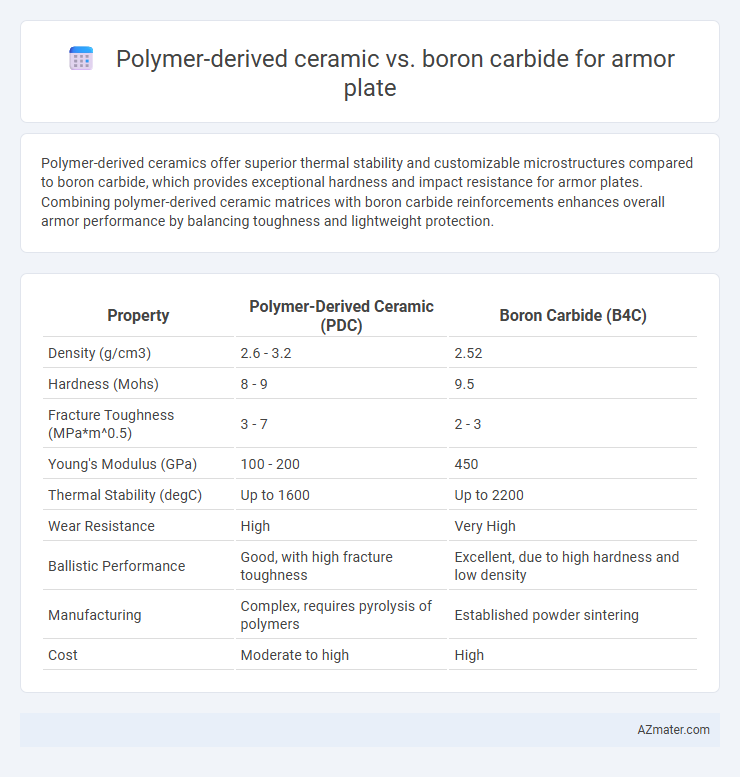Polymer-derived ceramics offer superior thermal stability and customizable microstructures compared to boron carbide, which provides exceptional hardness and impact resistance for armor plates. Combining polymer-derived ceramic matrices with boron carbide reinforcements enhances overall armor performance by balancing toughness and lightweight protection.
Table of Comparison
| Property | Polymer-Derived Ceramic (PDC) | Boron Carbide (B4C) |
|---|---|---|
| Density (g/cm3) | 2.6 - 3.2 | 2.52 |
| Hardness (Mohs) | 8 - 9 | 9.5 |
| Fracture Toughness (MPa*m^0.5) | 3 - 7 | 2 - 3 |
| Young's Modulus (GPa) | 100 - 200 | 450 |
| Thermal Stability (degC) | Up to 1600 | Up to 2200 |
| Wear Resistance | High | Very High |
| Ballistic Performance | Good, with high fracture toughness | Excellent, due to high hardness and low density |
| Manufacturing | Complex, requires pyrolysis of polymers | Established powder sintering |
| Cost | Moderate to high | High |
Overview of Armor Plate Materials
Polymer-derived ceramics (PDCs) and boron carbide (B4C) are advanced materials widely used in armor plate applications due to their exceptional hardness and lightweight properties. PDCs offer superior thermal stability and damage tolerance through their amorphous structure, enhancing multi-hit ballistic performance in protective gear. Boron carbide remains one of the hardest materials after diamond, providing excellent impact resistance and low density, which optimizes weight efficiency in personal and vehicle armor systems.
Introduction to Polymer-Derived Ceramics
Polymer-derived ceramics (PDCs) represent a class of advanced materials synthesized from preceramic polymers through controlled pyrolysis, offering unique microstructural control and enhanced toughness compared to traditional ceramics like boron carbide. PDCs exhibit superior thermal stability, oxidation resistance, and damage tolerance, making them promising candidates for next-generation armor plates that require high hardness and impact resistance. The versatility in tailoring the chemical composition and microstructure enables polymer-derived ceramics to overcome brittleness limitations found in boron carbide, improving performance in ballistic protection applications.
Boron Carbide: Properties and Applications
Boron carbide exhibits exceptional hardness, ranking third after diamond and cubic boron nitride, with a Mohs hardness of approximately 9.5, making it ideal for lightweight, high-strength armor plates. Its high elastic modulus (up to 460 GPa), low density (~2.52 g/cm3), and excellent fracture toughness enhance impact resistance and ballistic performance in military and personal protective equipment. Boron carbide's chemical inertness and thermal stability enable its application in extreme environments, outperforming polymer-derived ceramics in wear resistance and long-term durability for advanced armor systems.
Comparative Ballistic Performance
Polymer-derived ceramics (PDC) exhibit higher fracture toughness and better energy absorption compared to boron carbide (B4C), resulting in improved ballistic resistance and multi-hit capability in armor plates. Boron carbide remains favored for its superior hardness and lighter weight, which contributes to enhanced projectile penetration resistance but with increased brittleness under impact. The synergistic integration of PDC coatings on boron carbide substrates can optimize ballistic performance by combining toughness with hardness, addressing the limitations of each material in armor applications.
Weight and Density Analysis
Polymer-derived ceramics (PDCs) typically exhibit densities around 2.1 to 2.3 g/cm3, whereas boron carbide (B4C) has a higher density of approximately 2.52 g/cm3, offering lighter armor solutions by weight comparison. PDCs provide enhanced weight reduction with comparable hardness, contributing to improved mobility and reduced fatigue for wearers in personal armor applications. The lower density of PDCs enables design flexibility in armor plating, making them a promising alternative to boron carbide for advanced protective gear where minimizing weight is critical.
Toughness and Fracture Resistance
Polymer-derived ceramics (PDCs) exhibit enhanced toughness and superior fracture resistance compared to boron carbide (B4C) due to their amorphous structure and ability to dissipate energy through plastic deformation mechanisms. Boron carbide, while extremely hard and lightweight, tends to suffer from low fracture toughness and catastrophic brittle failure under high-velocity impact conditions. PDC-based armor plates demonstrate improved damage tolerance and multi-hit capability, making them a promising alternative for advanced protective applications.
Cost and Manufacturability
Polymer-derived ceramics (PDCs) offer cost advantages over boron carbide due to lower raw material expenses and simpler fabrication processes, enabling more scalable production of armor plates. Boron carbide boasts superior hardness and ballistic performance but requires energy-intensive sintering and machining techniques that increase manufacturing costs. The manufacturability of PDCs benefits from versatile shaping methods and reduced need for high-temperature densification, making them a more cost-effective choice for large-scale armor applications.
Durability and Environmental Resistance
Polymer-derived ceramics exhibit superior durability due to their ability to maintain structural integrity under high stress and thermal conditions compared to boron carbide armor plates. These ceramics resist oxidation and corrosion effectively, extending the lifespan of armor in harsh environmental conditions like extreme temperatures and humidity. Boron carbide, while lightweight and hard, tends to suffer from brittle fracture and reduced resistance to chemical degradation, limiting its environmental resilience relative to polymer-derived ceramics.
Adaptability in Modern Armor Systems
Polymer-derived ceramics (PDCs) offer superior adaptability in modern armor systems due to their tunable microstructure and lightweight properties, enabling customized defense solutions against specific ballistic threats. Boron carbide, while extremely hard and effective against high-velocity projectiles, presents limitations in fracture toughness and processing flexibility compared to PDCs. The integration of PDCs allows for enhanced impact resistance and multi-threat protection, making them increasingly preferable in advanced armor plate applications.
Future Trends in Ceramic Armor Materials
Polymer-derived ceramics (PDCs) offer enhanced toughness and thermal stability compared to traditional boron carbide, making them a promising material for next-generation armor plates. Research focuses on optimizing the microstructure of PDCs to improve ballistic performance and reduce weight while maintaining high hardness and impact resistance. Emerging trends emphasize hybrid composites combining PDCs with boron carbide to leverage the advantages of both materials in advanced protective armor systems.

Infographic: Polymer-derived ceramic vs Boron carbide for Armor plate
 azmater.com
azmater.com